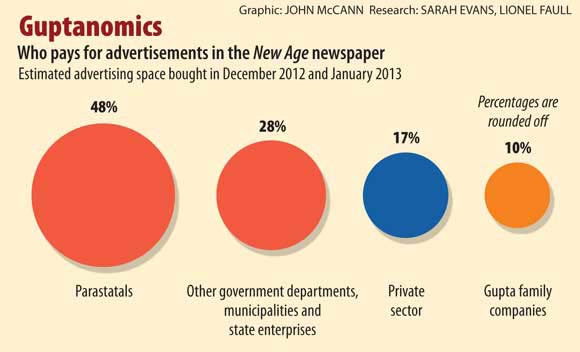Deputy press ombudsman Johan Retief has dismissed the complaints against five of the six stories the New Age wrote about Julius Malema's recent trip to London.
The ex-employee also alleged that on the instructions of the owners, the Gupta family, the returns were sent to India to be recycled. "They didn't want it done in South Africa in case it got out," said the source, who left the paper in 2011.
New Age's chief executive, Nazeem Howa, dismissed the allegation as "malicious", but refused to divulge details of the paper's returns or sales figures. The M&G had asked the newspaper to reveal its single- copy sales for the past six months; what percentage of its claimed
"50 000 sold-for copies" were bought in bulk by parastatals; and what percentage of its total revenue for the past six months came from the state. It had not done so by the time of going to print.
A survey of advertising space in the paper in December 2012 and January 2013 conducted by the M&G indicates that advertising bought by parastatals comprised roughly 48% of the total. Advertising purchased by other governmental departments, municipalities and state entities comprised 28%, and the Gupta family's companies, such as Sahara Computers and JIC Mining Services, bought about 10%.

The total amount purchased by the private sector was just 17%, with the main corporate advertisers being Anglo American, Coca-Cola and OUTsurance The New Age is not a member of the Audit Bureau of Circulations (ABC), meaning that its sales figures cannot be verified.
Howa told Politicsweb in mid-August 2012 that its print run was 100 000 copies. And in response to a City Press article at the weekend, he said the New Age's "sold-for copies" totalled "nearly 50 000".
Contravention of the rules
The gold standard for advertisers is accurate figures for single-copy sales, the newspapers that people spend their own cash on because they want to read them. Howa did not distinguish between single-copy sales and once-off bulk sales and subscription agreements with parastatals.
ABC typically declares both categories separately.
Writing on his blog this week, Anton Harber, the director of the Journalism Programme at Wits University, argued that "the state sector is probably in contravention of the rules and laws that govern their expenditure because they have no way of evaluating the New Age's advertising and sponsorship proposition".
The public finance magement act sets out the fiduciary duties of the boards of the public entties, including ensuring that expenditure is in the entity's best interest and taking steps to avoid fruitless and wasteful expenditure. Advertising revenue has performed strongly since the paper launched in December 2010, despite the lack of clarity about its sales.
According to market survey agency Nielsen, the newspaper raked in R49-million in advertising in the first half of 2012, propelling it into the top 10 of daily newspapers within 18 months of its launch.
Drastically inflated
A full-page advert, according to the paper's 2011 rates, cost R129 000. The former employee claimed this was "drastically inflated, especially because there are no circulation figures. But the parastatals still pay".
The ABC's slogan, "transparency you can see", reflects its primary objective: to "provide accurate and comparable circulation figures" to assist advertisers and publishers in buying and selling to each another. For advertisers, it is a way of assessing how much comparative bang for their buck they can get.
A circulation manager said: "It's great for the New Age: guaranteed government money and no way for anybody, government or the competition, to challenge its claims."
The latest available "All Media Products Survey" from the South African Audience Research Foundation (July 2011-June 2012) pegs the New Age at an average daily readership of 87 000. The average reader-to-copy sale ratio for the New Age's daily news competitors is 7:1, which means that the New Age's copy sale figure could be pegged at 12 428. This is a long way short of Howa's 50 000 "sold-for copies" claim, unless his figures are padded out with bulk sales to government entities.
* Got a tip-off for us about this story? Email [email protected]

The M&G Centre for Investigative Journalism (amaBhungane) produced this story. All views are ours. See www.amabhungane.co.za for our stories, activities and funding sources.